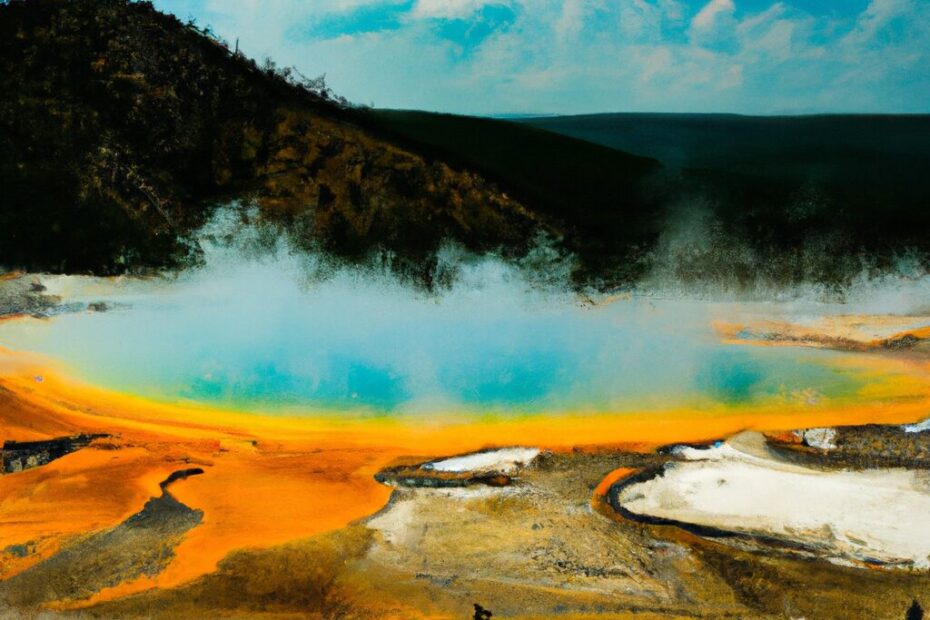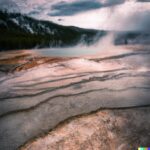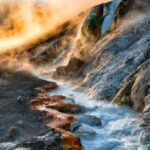Have you ever marveled at the beauty and power of hydrothermal features in Yellowstone National Park? From geysers to hot springs, these natural wonders are a sight to behold. But what exactly are hydrothermal features, and how are they connected to geysers?
In this article, we will explore the different types of hydrothermal features, where they can be found, what causes them, and their relationship to geysers. Join us as we delve into the fascinating world of hydrothermal features in Yellowstone.
What Are Hydrothermal Features?
Hydrothermal features refer to natural geological formations found in various regions, with Yellowstone National Park being a prime example of a hotspot for such phenomena.
These features are a result of the Earth’s internal heat interacting with underground water, creating a unique environment where geysers, hot springs, and other geothermal activities flourish. The presence of hydrothermal features is not just visually stunning; it also plays a crucial role in understanding the geological processes shaping our planet.
In locations like Yellowstone, these features serve as indicators of the underlying volcanic activity and the movement of tectonic plates. Visitors to Yellowstone National Park are often mesmerized by the vibrant colors and powerful displays of geysers like Old Faithful, showcasing the dynamic nature of hydrothermal features.
What Are The Different Types Of Hydrothermal Features?
Various types of hydrothermal features exist, each showcasing unique characteristics shaped by factors such as volcanic activity, geologic formations, and thermal anomalies.
- One category of these features is geysers, which are known for their explosive eruptions of hot water and steam. Geysers are typically situated near volcanic regions, where underground water is superheated by magma before surging upwards under pressure.
- Thermal springs, another type of hydrothermal feature, are characterized by the gentle flow of heated water to the surface. These springs are often found in areas with fractured rock formations that allow water to percolate deep underground and absorb heat from the Earth’s interior.
Where Can Hydrothermal Features Be Found?
Hydrothermal features can be found in diverse locations globally, often associated with geothermal reservoirs, underground water sources, and regions exhibiting thermal anomalies.
These unique geological wonders are commonly found along tectonic plate boundaries, where molten rock from the Earth’s mantle heats groundwater, creating hot springs, geysers, and fumaroles. The distribution of hydrothermal features extends across various continents, including Yellowstone National Park in the USA, the Taupo Volcanic Zone in New Zealand, and the Great Rift Valley in Africa. Thermal anomalies play a crucial role in pinpointing these locations, as they indicate areas where the Earth’s heat is escaping to the surface, giving rise to fascinating natural phenomena.
What Causes Hydrothermal Features?
The formation of hydrothermal features is driven by intricate processes involving water circulation, the presence of sulfuric compounds, and a reliable heat source originating from volcanic or geothermal activity.
These hydrothermal systems are fascinating geological phenomena that showcase the dynamic interaction between Earth’s internal heat and surface water. Through a series of complex underground pathways, water seeps down into the Earth’s crust, where it is heated by the underlying magma chambers. As the water becomes superheated, it absorbs various minerals and gases, including sulfuric compounds, before resurging to the surface. This circulation of water laden with dissolved minerals leads to the deposition of colorful mineral formations, such as terraces, geysers, hot springs, and fumaroles.
How Does Volcanism Play A Role In Hydrothermal Features?
Volcanism significantly influences hydrothermal features through its contribution to mineral deposits, the activation of geothermal vents, and the facilitation of hydrothermal processes within the Earth’s crust.
These hydrothermal features play a vital role in the Earth’s geological processes, acting as conduits for hot fluids rich in minerals that circulate through fractures and fissures formed by volcanic activities. As these fluids rise towards the surface, they deposit minerals, creating valuable resources that are often sought after by industries for various applications.
Geothermal vents, which are openings in the Earth’s crust where geothermally heated water and steam are released, harness the intense heat generated by volcanic systems to produce clean and sustainable energy that can power homes and businesses. The intricate interaction between volcanism and hydrothermal processes continually shapes the Earth’s landscape and provides a glimpse into the dynamic nature of our planet’s geology.
What Is The Role Of Water In Hydrothermal Features?
Water plays a crucial role in hydrothermal features, influencing the hydrogeology of an area, sustaining microbial life within geothermal systems, and serving as a primary medium for heat transfer and mineral deposition.
The presence of water in hydrothermal systems is fundamental to the cyclical processes that maintain the dynamic equilibrium of geothermal reservoirs. Hydrothermal fluids, rich in dissolved minerals, are propelled through fractures and conduits deep within the Earth’s crust, where they interact with heat from the molten magma beneath. This interaction not only drives the circulation of water but also facilitates the transfer of thermal energy to the surface. Water brings essential nutrients and chemical compounds that support the proliferation of diverse microbial communities thriving in these extreme environments.
How Do Rocks And Minerals Affect Hydrothermal Features?
The composition of rocks and minerals plays a vital role in shaping hydrothermal features, influencing thermal energy distribution, providing insights into geologic history, and contributing to the diversity of geothermal phenomena.
These geologic structures act as conduits for hot water and steam below the Earth’s surface, creating geothermal features like hot springs, geysers, and fumaroles. Rocks with high permeability such as fractured basalt allow for efficient heat transfer and storage.
The minerals present in these formations serve as indicators of past geological processes, revealing valuable information about the Earth’s history through their mineral composition and crystal structures. Subsequent deposition and alteration of minerals in hydrothermal systems record changes in temperature and pressure, preserving a timeline of geological events over time.
What Are The Most Famous Hydrothermal Features In Yellowstone?
Yellowstone National Park boasts some of the most iconic hydrothermal features globally, including the renowned Old Faithful Geyser, mesmerizing Grand Prismatic Spring, captivating Mammoth Hot Springs, and the dynamic Norris Geyser Basin.
These attractions are not just visually stunning but also hold significant geological importance. The Old Faithful Geyser, known for its timely eruptions shooting boiling water up to 180 feet, showcases the park’s dynamic thermal activity. The Grand Prismatic Spring, with its vibrant rainbow-colored waters caused by thermophiles thriving in its hot waters, is a true marvel to behold. Visitors can marvel at the terraces of Mammoth Hot Springs, created by the mineral-rich water flowing over travertine deposits, while the unpredictable geysers of Norris Geyser Basin are a constant reminder of the park’s ever-changing landscape and underground geothermal energy reserves.
Old Faithful Geyser
Old Faithful Geyser stands as a testament to the marvels of nature, captivating visitors with its predictable eruptions, stunning geologic features, and the enchanting display of geyser activity.
The geological wonders of Old Faithful Geyser lie in its intricate underground network where superheated water and steam accumulate. Eruptions occur when the pressure builds up in these channels, causing the water to be forcefully expelled through the geyser’s vent. One of the unique features contributing to the reliability of its eruptions is the constriction of its geyser plumbing system. This constriction acts like a natural valve, ensuring that the pressure builds up to a certain point before releasing in a spectacular display. Such behaviors exemplify the fascinating dynamics of geothermal features in Yellowstone’s volcanic landscape.
Grand Prismatic Spring
Grand Prismatic Spring captivates onlookers with its vibrant colors, intricate hydrothermal vents, picturesque thermal spring, and the stunning backdrop of its unique geologic setting within Yellowstone National Park.
The hydrothermal vents found at Grand Prismatic Spring are a testament to the incredible geothermal activity beneath the Earth’s surface, creating a mesmerizing display of steam and bubbling water. These vents release heated water rich in minerals, contributing to the striking rainbow hues that adorn the spring. The thermal spring itself boasts temperatures hot enough to support unique microbial life forms, thriving in conditions that mimic early Earth environments.
Such geological marvels not only offer a visual feast for visitors but also provide scientists with vital insights into the formation and behavior of geysers and thermal vents.
Mammoth Hot Springs
Mammoth Hot Springs showcases the dynamic interplay of geologic forces, featuring terraces sculpted by hydrothermal conditions, a captivating geologic environment, and the enduring legacy of geological processes at work.
The unique geologic environment of the area is a result of the combination of heat, water, and underground volcanic activity that shapes the landscape. The hydrothermal conditions present at Mammoth Hot Springs have created a mesmerizing display of colorful terraces, with minerals such as travertine being deposited over time. These terraces are a visible reflection of the underlying geologic processes that have been ongoing for thousands of years, making Mammoth Hot Springs a prime example of geothermal resources intersecting with fascinating geological conditions.
Norris Geyser Basin
Norris Geyser Basin offers a treasure trove for geothermal studies, providing valuable geologic evidence, serving as a hub for geysers research, and contributing to our understanding of hydrothermal phenomena.
Researchers have long been drawn to the unique geothermal features of Norris Geyser Basin, which include geysers, fumaroles, and hot springs. These natural wonders offer a snapshot of the Earth’s internal processes and the complex interactions between magma chambers and groundwater. Through detailed geologic mapping and monitoring, scientists can unravel the mechanisms driving geyser eruptions and better comprehend the thermal dynamics at play. This ongoing research not only enhances our knowledge of geysers within Norris Geyser Basin but also provides valuable insights into the broader field of geothermal science.
What Is The Connection Between Hydrothermal Features And Geysers?
The interconnection between hydrothermal features and geysers unveils a fascinating relationship, shaping the behavior, activity, and distinctive characteristics exhibited by these natural wonders.
Hydrothermal features, such as hot springs and fumaroles, contribute to the dynamic nature of geysers. The intricate processes occurring beneath the Earth’s surface where water interacts with hot rocks and volcanic activity play a crucial role in triggering geyser eruptions. These hydrothermal processes create a pressure buildup, leading to the iconic spouting of water and steam seen in geysers. Understanding these phenomena provides valuable insights into the geological forces at play and the continuous evolution of these remarkable geothermal features.
How Do Hydrothermal Features Create Geysers?
The formation of geysers is intricately linked to the presence of hydrothermal features in specific geologic settings, showcasing the vast geothermal potential and the mesmerizing geologic phenomena that give rise to these natural marvels.
Geysers typically form in areas where underground volcanic activity heats groundwater, creating intense pressure that pushes the superheated water and steam upwards through narrow openings in the Earth’s crust. The geologic settings play a crucial role in nurturing these geysers, with features like fractured rock formations allowing for the necessary pathways for the water and steam to travel. The presence of a magma chamber near the Earth’s surface can significantly contribute to the continuous energy supply needed to sustain the geyser activity over time.
What Is The Relationship Between Hydrothermal Features And Geyser Eruptions?
The mesmerizing spectacle of geyser eruptions is intricately tied to the underlying geologic processes, the rhythmic nature of geyser activity, and the structural integrity of the geological formations that define these captivating events.
As hydrothermal features unleash their pent-up energy through geyser eruptions, it is the interplay between hot water reservoirs and conduits that fuels these explosive displays. The geologic processes at work involve the heating of groundwater deep within Earth’s crust, creating immense pressure that eventually bursts forth in a dazzling array of steam and water.
The regularity of geyser activity is often influenced by factors such as heat sources, the existence of underground plumbing systems, and the variability of water supply. The geological structures, like faults and fractures, not only serve as conduits for the hydrothermal fluids but also determine the direction and intensity of these iconic eruptions.
How Do Hydrothermal Features Change Over Time?
The evolution of hydrothermal features over time offers valuable insights into the geological history of a region, the geothermal exploration potential, the chemical interactions shaping hydrothermal fields, and the geologic origin of these dynamic phenomena.
As hydrothermal features undergo a transformative journey, their interactions with the Earth’s subsurface and the surrounding environment play a crucial role in their development. Over time, the geologic processes at work sculpt these formations, creating intricate structures and releasing mineral-rich waters that support unique ecosystems.
By examining the evolution of hydrothermal features, scientists can unravel the complex interplay between geology and chemistry, shedding light on the mechanisms that sustain these geothermal wonders. This exploration not only enhances our understanding of Earth’s natural processes but also underscores the importance of geothermal energy research in harnessing the immense potential of these geological marvels.
Last Updated on February 7, 2024 by Jon Waraas – Originally Posted: February 7, 2024

I’m Jon Waraas, and I’ve been navigating the online world since 2006. By day, I’m the proud owner of some eCommerce gems, and by night, I’m the voice behind the adventures on Waraas.Com.
My heart, however, belongs to the wild beauty of Yellowstone National Park. I’ve got a collection of websites dedicated to sharing the wonders of this natural masterpiece. Oh, and did I mention? I’m currently building my own cabin inside the ghost town of Gilmore, Idaho – a cabin with tales to tell!
When I’m not immersed in the digital realm, you’ll find me lacing up my boots for a good hike or setting up camp under the star-studded sky.




